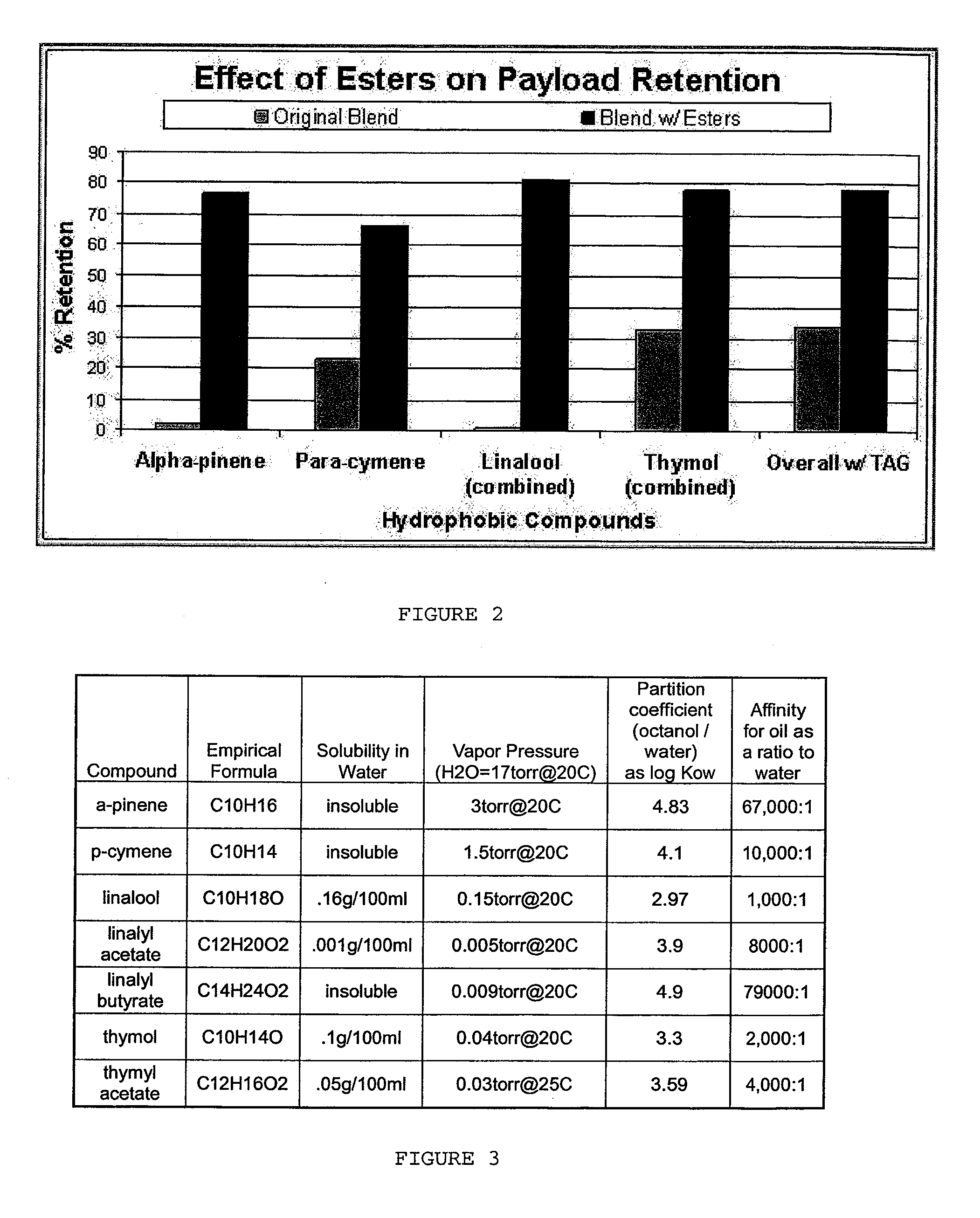Delivery of Functional Compounds
a functional ingredient and ether technology, applied in the field of ether-containing functional ingredients, can solve the problems of insufficient capital expenditure, insufficient use of additional materials, and insufficient achieve the effects of improving the microencapsulation efficiency of functional ingredients, fine emulsions, and stable emulsions
- Summary
- Abstract
- Description
- Claims
- Application Information
AI Technical Summary
Benefits of technology
Problems solved by technology
Method used
Image
Examples
example 1
The Evaluation and Selection of Emulsifiers
[0049]Various emulsifiers were combined with deionized water at 60 C to produce 2% solutions. The resulting solutions were combined with an essential oil blend composition (4% alpha-pinene, 30% para-cymene, 7% linalool, and 35% thymol and 24% soybean oil) in a 50:50 weight ratio with deionized water to create an oil-in-water emulsion. The emulsifiers evaluated were Glycosperse S-20 KFG (Lonza; Fairlawn, N.J.), Polyaldo 10-1-0 KFG (Lonza; Fairlawn, N.J.), Aldosperse MS-20 KFG (Lonza; Fairlawn, N.J.), Polyaldo 10-2-P KFG (Lonza; Fairlawn, N.J.), Ryoto sugar ester (S-1570, Mitsubishi-Kagaku Food Corp.; Tokyo, Japan), Precept 8120 (Central Soya; Fort Wayne, Ind.) and sodium caseinate (Alanate-180, New Zealand Dairy Board; Wellington, New Zealand). The sucrose ester (S-1570) was identified as the best emulsifier due to the creation of the smallest and most uniformly dispersed oil droplets within the emulsion. The emulsion created with the sucros...
example 2
Microencapsulation of a Functional Ingredient Containing Some Esterified Components in a 75% Shellac / 25% Zein Matrix
[0050]2400.0 g of distilled, ionized water (D.I.H20) was added to a beaker mixed using StedFast Stirrer SL1200 (Yamato Scientific; Tokyo, Japan) with a 4-pronged impeller blade at speed setting between 5 and 6. 37.5 g of Jet Milled zein (F4000, Freeman Industries; Tuckahoe, N.Y.) powder was added to the beaker and mixed until uniformly dispersed. Next, 10% NaOH aqueous solution was added until the pH reached 11.3. The zein-water mixture was agitated until the zein powder was completely dissolved and the solution was translucent. Next, 450.0 g of the pre-made shellac (Temuss #594; Ajax, ON., Canada) in ammonium hydroxide solution (25% solids) was added and mixed for 5-10 minutes. Finally, 1.4 g of sucrose stearate, S-1570 (Mitsubishi-Kagaku Food Corp.; Tokyo, Japan) was added while mixing, such as for 5-10 minutes until homogeneous mixing has occurred.
[0051]Next, 80.0 g...
example 3
Microencapsulation of a Functional Ingredient Containing Some Esterified Components in 75% Shellac / 25% Zein Matrix at a Pilot Plant Scale
[0055]12 kg of water and 7.5 g of sucrose stearate (S-1570, Mitsubishi-Kagaku Food Corp.; Tokyo, Japan) was added to a mixing tank and mixed for 1-2 minutes. Then 2.25 kg of pre-made shellac solution (Temuss #594; Ajax, ON., Canada) in ammonium hydroxide solution (25% solids) was added, followed by 187.5 g zein powder (F4000, Freeman Industries; Tuckahoe, N.Y.). 10% sodium hydroxide solution was metered in until pH reached 11.3 (to solubilize zein). Once the zein and shellac are completely in solution, 400 g of essential oil blend (13% canola oil, 10% alpha-pinene, 25% para-cymene, 12% linalyl acetate, and 40% thymyl acetate) was added. The mix was agitated for 5 minutes to create an emulsion.
[0056]The emulsion was titrated with 3.0 percent citric acid solution until the pH reached 3.9. 75 g of Si02 AB-D (PPG Industries; Pittsburg, Pa.) was added a...
PUM
| Property | Measurement | Unit |
|---|---|---|
| particle size | aaaaa | aaaaa |
| particle size | aaaaa | aaaaa |
| droplet size | aaaaa | aaaaa |
Abstract
Description
Claims
Application Information
 Login to View More
Login to View More - R&D
- Intellectual Property
- Life Sciences
- Materials
- Tech Scout
- Unparalleled Data Quality
- Higher Quality Content
- 60% Fewer Hallucinations
Browse by: Latest US Patents, China's latest patents, Technical Efficacy Thesaurus, Application Domain, Technology Topic, Popular Technical Reports.
© 2025 PatSnap. All rights reserved.Legal|Privacy policy|Modern Slavery Act Transparency Statement|Sitemap|About US| Contact US: help@patsnap.com



